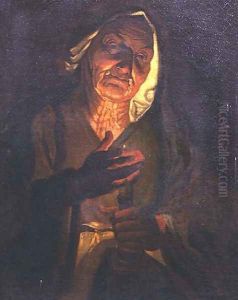(follower of) Stomer, Matthias Paintings
Matthias Stom, also known as Matthias Stomer, was a Dutch Golden Age painter who was active primarily in Italy during the 17th century. He was born around 1600 in Amersfoort, in the Dutch Republic, though specific details about his early life and training are not well-documented. Stom's work is often associated with the followers of Caravaggio, due to his use of dramatic chiaroscuro and his focus on genre scenes, religious subjects, and portraits that feature deep shadows and intense light contrasts.
Stom traveled to Rome early in his career, which was a common destination for artists of the time seeking to study the works of Caravaggio and his followers. Caravaggio's influence is evident in Stom's paintings, which exhibit a similar use of lighting and a focus on the emotional intensity of the subjects. Stom's works are characterized by a strong sense of realism and attention to detail, often employing a limited color palette that enhances the dramatic effect of the lighting.
After spending time in Rome, Stom moved to southern Italy and worked in various cities including Naples, Sicily, and Malta. His time in Naples was particularly productive, and he became part of a group of painters known as the 'Caravaggisti,' artists who adopted Caravaggio's style. Stom's paintings from this period demonstrate his mastery of the tenebrist technique, where stark light-dark contrasts create a sense of volume and form.
Matthias Stom's exact date of death is not known, but historical records suggest that he was still living in Sicily in 1652. Unlike some of his contemporaries, Stom did not achieve widespread fame during his lifetime, and his works were often attributed to other artists. However, in the centuries since his death, his paintings have been reevaluated, and he is now recognized as an important figure in the Caravaggesque movement. Today, Stom's works can be found in various museums and private collections around the world, and they continue to be studied for their contribution to the development of European art in the Baroque period.
